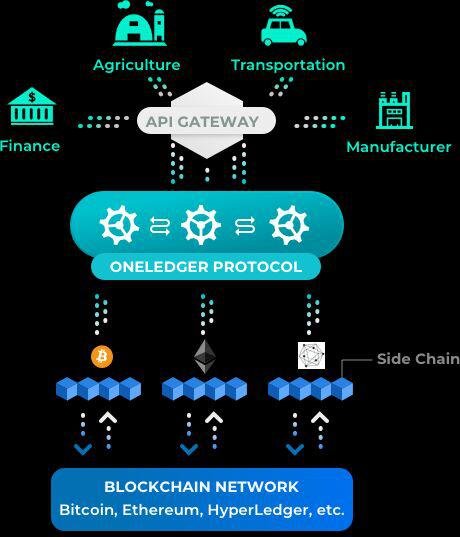The OneLedger value network is composed of various levels of service regions and business logic.Managing an identity, pseudonymous or otherwise, across multiple distributed networks can be done by assigning a master private / public key-pair to an identity. This master key-pair can then be used to associate any other public keys to this identity by digitally signing a message with the private key of the master key-pair. OneLedger offers a universal identity solution to keep track of users’ assets that are stored on multiple distributed databases.
Often, businesses or individuals may wish to deploy dAPPs on multiple platforms. As such, developers have to write and deploy smart contracts on each platform of choice, potentially in multiple languages. OneLedger is developing an SDK that eases this process of porting and deploying smart contracts across multiple platforms. OneLedger’s SDK will allow for users to define a “master smart contract” that specifies the smart contract written in each language of choice. The developer can then launch the dAPP on multiple platforms at once by specifying the desired platforms within the master smart contract.

The primary client-side interface is a REST API allowing applications to register users, query the blockchain, and issue transactions. A set of APIS are made available for chain code to directly interact with the stack to execute transactions and query transaction results. The service-side programming interface is a business portal for users to effortlessly build business models and functions to project real world functions onto blockchain.
They hope develop an extendable interface that is fast, safe, extendable and agnostic, allowing for easy deployment of decentralized applications (DApps) and cross-ledger communication. At its core, the purpose of the extendable blockchain interface is to effectively access and communicate across multiple ledgers.This decentralized framework changes the basis upon how applications are built by ultimately unifying and realizing the real world into its blockchain parallel.
Through the platform’s portal business tools, the originator can then quickly set up the agreement and service template in circulation such as supply chain, law service agreements, and distribution agreements. The originator may assign a public identity to a group and can also define roles to individual identities or to all public identities in a group created by the originator. At the same time, the circulation defines the implementation of the agreement in order to ensure the interests of the parties involved are accounted for. Once completed, this service or agreement would be translated into a Solidity contract or other chain code. Once the circulation starts, all parties involved immediately binds the participant to circulate and execute in the form of an intelligent contract.

The principal tools of the OneLedger Business Application Development Kit are listed below:
Digital Asset: The initiator can define assets in both the flow and process including financial, production, or content assets;
Module: Contains complex business logic. Includes aggregation of workflow and process; and
Workflow/Process: Basic unit used to build a module - function that can be executed based on OneLedger protocol to complete certain tasks including transaction with crossing blockchain, business flow mapping, and runtime data synchronization.
Role Access Control: The decentralized signature system will sign and validate the user together with the associated identifier information whether it be password, organization information, or role; once validated, access information can be packed into the payload and delegated to modules.
Transaction: Runtime environment for asset and its workflow/process where a transaction can come across from different blockchainsbased on OneLedger protocol.
Channel: A P2P channel with emphasis on speed and security to connect two nodes within a single or multiple blockchains.
Connector: Enterprise-level integration tool for various Business regions; connector integrates OneLedger Public Blockchain data with existing centralized commercial network, and establishes a hybrid application combining blockchain and centralized services.
1 billion OLT tokens will be produced. Each OLT token will initially be mapped to one corresponding ERC20 token so early adopters of OLT can use them on Ethereum ecosystem as the OneLedger ecosystem is being developed.Softcap is marked for 4 million USD and hardcap is marked for 15 million USD in the ICO phase. There are 2 presales targeting 6 million USD and 3 million USD respectively and the public sale is targeted for 5 million USD.
The token distribution is as follows.
• 35% - Sale Distribution
• 25% - Community Reserve
• 15% - Team & Advisors
• 15% - Marketing and Long-term partners
• 10% - Company Reserve
For more information on Oneledger project, visit https://oneledger.io , the official Oneledger website.
Hi! I am a robot. I just upvoted you! I found similar content that readers might be interested in:
https://oneledger.io/wp-content/uploads/2018/04/oneledger-whitepaper.pdf
Downvoting a post can decrease pending rewards and make it less visible. Common reasons:
Submit
Congratulations @naleerkhan! You received a personal award!
You can view your badges on your Steem Board and compare to others on the Steem Ranking
Vote for @Steemitboard as a witness to get one more award and increased upvotes!
Downvoting a post can decrease pending rewards and make it less visible. Common reasons:
Submit